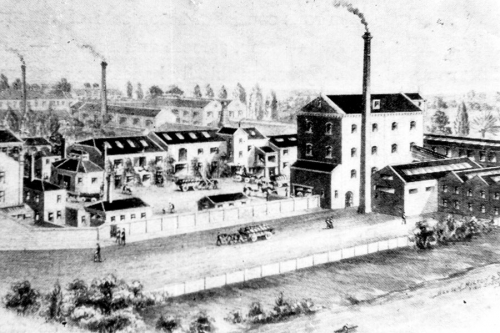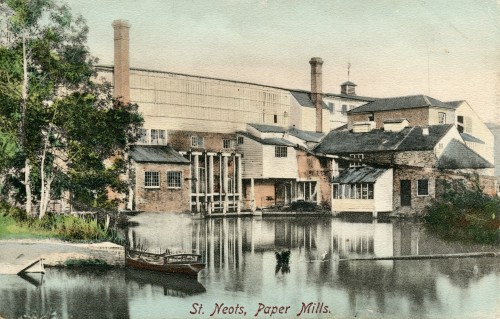Huntingdonshire was an historic county until it was merged with Cambridgeshire in 1974. However, in 1984, the district was reinstated as a non-metropolitan county. In 2002, Huntingdonshire Day was established on the former county’s most famous son Oliver Cromwell’s birthdate – 25 April. For me Huntingdonshire will always be.

My family roots hail from Huntingdonshire and in particular St Neots which sits right on the boundary of old Bedfordshire and Huntingdonshire along the Great Ouse. I descend from the families Paine and McNish. The Paines had long been established in the area as farmers at Toseland Hall and were well known in the small market town, and county, as owners of Paine’s Brewery (1831-1985). In fact the Paines descend from dubious beginnings from an illegitimate son of Sir George Downing, 2nd Baronet – son of “Mr Downing Street” – and Priscilla Paine of East Hatley, Cambridgeshire; but that’s a story for another time.

(James Paine)
Aside from the brewery, my family also had several other business holdings scattered about the streets, including Nutters Mill on Bedford Street, so called because the street was formerly Nutters Lane. It was later known as Bedford Street Mills. Paine’s Brewery, on the south-side of the Market Square, already had within its complex a beam steam engine-powered stone flour mill since 1840. The family business began with James Paine in 1831 purchasing the Market Square site from William Foster1.

(John Bull mill and yard off St Neots Market Square)

(William Paine)
There have been three flour mills on the Bedford Street site, the first dating from 1846 and built by John Medlock. He sold it to Joshua Malden in 1855 for £740, thence to Thomas Smith in 1859 for £921. The mill entered my family in 1865 when my 3rd great grandfather William Paine (1816-1896) purchased it for £8001.
This was part of his expansion of the family business which he begun after his father’s death in 1855 and dissolution of the partnership with his younger brother James. He added a sawmill to the site around the same time, with maltings next door. In 1879, the original mill building and sawmill were pulled down to make way for a more modern combined millstone and roller flour mill that was built on the site and fitted by “Mr C. Hopkinson, of Retford”2. The sawmill’s steam engine was sold to Daintree and Jewson in the town; William Jewson having apprenticed under William Paine at his timber yard1. In 1889, the combination plant was stripped out and a complete roller plant installed by Hopkinson. Robinsons of Rochdale took over from Hopkinson and in 1899 remodelled the plant, and again in 1907 by adding their “cyclo-pneumatic scalping system”.2

(John McNish and Alexander Copland McNish)
Enter the McNishs. Two Scottish brothers from Manchester moved to St Neots in 1872. My 2nd great grandfather, John McNish (1851-1913) married William Paine’s eldest daughter Alice and he, along with his brother Alexander, who had married another of William Paine’s daughters, Rosa – of William’s 14 children just four daughters survived – entered the family business bringing capital from their late father’s Manchester building firm, becoming partners in 1877 and 1882 respectively. Their partnership did not last, with John retaining ownership in 18963.

In 1888 John McNish formed a consortium, the St Neots Paper Mill Company, and took over the running of the water-powered paper mill north of the town along with five other businessmen1.

(Paine and Co Ltd Offices [St Neots Museum Ref SNEMU1995.1.4.44])
The early 1900s saw devastation hit the Paine’s mills. First on 19 October 1905, the brewery and stone flour mill on the Market Square, known as ‘John Bull’ Mill, were destroyed by fire, and quickly rebuilt in 1906 – two more fires followed in 1947 and 1955 at their malt extract factory. The McNish family continued to run it until it closed in 1985 bringing to an end 150 years of family-run brewing in the town. The flour mill and a significant amount of original buildings survive and are Grade II Listed.

(Bedford Street Roller Flour Mill)
On 10th January 1909, Bedford Street Mills was destroyed by fire. The Miller describes the flames of the “great fire…leaping to a height of some 30ft above the tall chimney shaft”2. It was rebuilt the same year the in the magnificent Gothic-revival form that still stands today, known locally as the ‘Paine’s Cathedral’, and included a complete modern roller plant. It was truly a family mill as its architect was Edward Jabez Paine (1847-1926), nephew of William Paine and grandson of the founder James Paine. He had earlier worked on the reconstruction of the brewery and its mill in 1906. In 1964, John McNish’s great grandson Rob McNish took over managment off the mill leaving in 1985. The flour mill closed in 1990 and the majority of the buildings were pulled down for redevelopment. The Grade II Listed ‘Cathedral’ survives as converted apartments and office space and was listed in 1974 ‘for curiosity value’.
Then on 12th May 1912, the paper mill was destroyed and immediately rebuilt as a more modern paper mill. After John’s death in 1913 – having retired as chairman in 1909 – the consortium continued under his son Wellwood McNish as Chairman and Managing Director of Paine and Co Ltd.

(A. Wellwood McNish)
The depression took its toll on the mill and it closed in 1939. It was taken over by Wiggins Teape Ltd during the Second World War, but again closed in 1947 having turned over to the manufacture of nylon. Samuel Jones Ltd took the mill over for its final run as a paper mill, finally closing its doors in 2000. The paper mill was subsequently demolished, and the site redeveloped.
The Paine and Co Ltd businesses may be long gone, but the associated buildings continue to be landmarks of the town.
Photographs from Guy Boocock unless otherwise stated.
1. Tebbutt, C. F., St. Neots, The History of a Huntingdonshire Town (Phillimore, 1978), pp.139-144, 301-302.
2. The Miller, 1 February 1909, p. 746.
3. The London Gazette, 21 February 1896, p. 1058.
